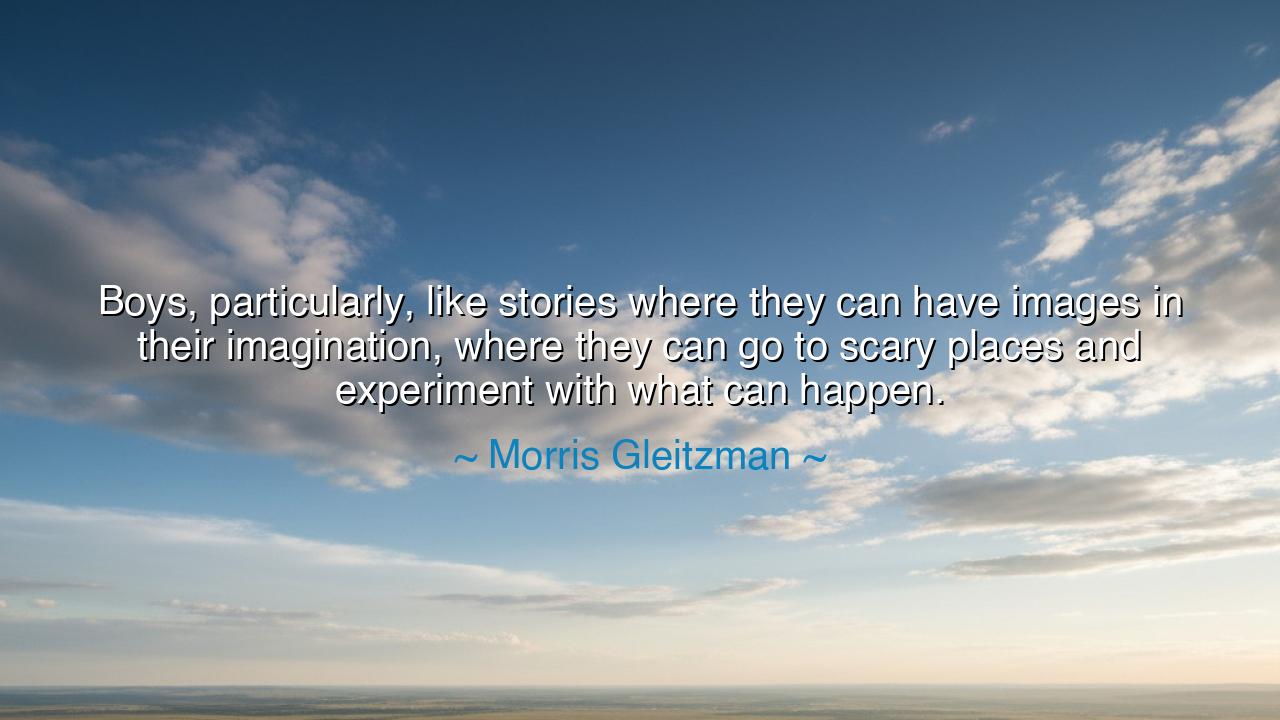
Boys, particularly, like stories where they can have images in
Boys, particularly, like stories where they can have images in their imagination, where they can go to scary places and experiment with what can happen.






When Morris Gleitzman declared, “Boys, particularly, like stories where they can have images in their imagination, where they can go to scary places and experiment with what can happen,” he was not merely speaking of tales or of childhood fancy. He was describing a sacred journey—the ancient rite of growing, dreaming, and discovering through imagination. His words speak to the heart of how the young learn to face the unknown: not through command or rule, but through story, where danger is safe, and fear becomes a teacher.
For in every age, the young mind has sought not comfort, but adventure. The boy at play with sword-shaped stick or paper ship is not escaping reality—he is learning to master it. Through the scary places of imagination, he meets the dragons of fear, of doubt, of weakness—and learns, even in pretend, how to stand against them. These stories are not trivial diversions; they are the quiet classrooms of courage. When the child dares to imagine the shadow, he prepares his spirit for the darkness that real life will one day bring.
The ancients knew this well. In every culture, the elders told stories of monsters and heroes, not to frighten their children, but to awaken their strength. The Greeks told of Perseus and the Gorgon; the Norse spoke of Thor and the serpent; and in far-off Japan, children grew up hearing of brave samurai who stood against the impossible. The fear in these tales was never the enemy—it was the forge in which character was made. So too does Gleitzman remind us: the young do not wish to be shielded from the unknown, but invited to face it through the images in their imagination.
Consider the tale of J.R.R. Tolkien, a man who, having witnessed the horrors of war, turned them into a story of bravery and hope. In The Hobbit and The Lord of the Rings, countless boys—and indeed, countless souls—found the courage to confront fear. When young readers walked beside Frodo through dark lands, or stood with Aragorn before impossible odds, they too learned that fear can be faced, and evil can be endured. Through imagined danger, they rehearsed the heroism that real life one day would demand.
The power of imagination lies in this sacred paradox: it allows us to experiment with what can happen without being destroyed by it. A story becomes a mirror of the inner world, where the soul can test its strength, question its limits, and discover its hidden light. The boy who trembles as he turns the page, yet reads on, is already practicing bravery. He learns that fear does not end the story—it deepens it. And this lesson, once learned, will serve him long after the book is closed.
But Gleitzman’s words hold another wisdom still: the call to storytellers, parents, and teachers to honor the imagination of youth. Too often, in their zeal to protect, adults build walls around the young spirit. Yet imagination withers when caged. A boy must be allowed to dream of danger, to explore mystery, to create worlds that frighten and fascinate. For it is in these acts of creation that empathy, resilience, and understanding take root. To deny the imagination its wildness is to deny the soul its growth.
Therefore, let this be the lesson for all generations: Nurture the imagination, but do not tame it. Encourage the young to read, to dream, to tell stories of their own making. Let them venture into the woods of thought and return stronger, wiser, braver. For through such journeys, they become not just readers or dreamers, but architects of the self—builders of courage and compassion.
So remember, as Gleitzman teaches, that the scary places of imagination are not to be feared. They are the testing grounds of the heart. Every story told, every image imagined, is a torch passed to the next traveler on the road of life. And if we dare to keep that torch lit, then each child who follows may yet grow into a hero, not only in fantasy, but in truth.






AAdministratorAdministrator
Welcome, honored guests. Please leave a comment, we will respond soon